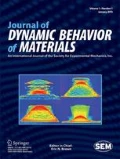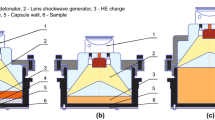Abstract
When a material is submitted to a dynamic compression, a shock wave propagates through the bulk and potentially interacts with a free surface. If this surface has geometrical defects such as grooves, some material ejection can occur. The energy of the high velocity ejecta is an area of concern for many applications, such as industrial safety, pyrotechnics or inertial confinement fusion. We have studied this phenomenon of microjetting from calibrated grooves in laser shock-loaded Cu samples, combining complementary experimental, numerical and analytical approaches, in order to investigate the formation and the fragmentation of the jets over ranges of small spatial (~µm) and temporal (~ns) scales and extremely high strain rates (~107 s−1). Various grooves were used with different depths and aperture half-angles (20°, 30°, 45°). The velocities measured by fast shadowgraphy and heterodyne velocimetry were compared to numerical predictions using the finite element or the smoothed particles hydrodynamics formulations with the Radioss code. Size distribution of the ejecta was inferred from rough measurements of the debris sizes and compared to analytical predictions from a probability law.












Similar content being viewed by others
References
Asay JR, Mix LP, Perry F (1976) Ejection of material from shocked surfaces. Appl Phys Lett 29:284
Andriot P, Chapron P, Olive F (1981) Ejection of material from shocked surfaces of tin, tantalum and lead-alloys. AIP Conf Proc 78:505–509
Zellner MB et al (2007) Effects of shock-breakout pressure on ejection of micron-scale material from shocked surfaces. J Appl Phys 102:13522
Buttler WT et al (2012) Unstable Richtmyer-Meshkov growth of solid and liquid metals in vacuum. J Fluid Mech 703:60–84
De Rességuier T et al (2014) Microjetting from grooved surfaces in metallic samples subjected to laser driven shocks. J Appl Phys 115:043525
Lescoute E et al (2010) Ejection of spalled layers from laser shock-loaded metals. J Appl Phys 108:093510
Mercier P et al (2009) PDV measurements of ns and fs laser driven shock experiments on solid targets. AIP Conf Proc 1195:581–584
Loison D et al (2012) Skew photonic Doppler velocimetry to investigate the expansion of a cloud of droplets created by micro-spalling of laser shock-melted metal foils. J Appl Phys 112:113520
Roland C et al (2015) Hydrodynamic simulations of microjetting from shock-loaded grooves. J Phys Conf Ser. Under publication
Colombier JP et al (2005) Hydrodynamic simulations of metal ablation by femtosecond laser irradiation. Phys Rev B 71:165406
Bushman AV, Lomonosov IV, Fortov VE (1992) Equations of state of metals at high energy densities. Russian Academy of Sciences,Institute of Chemical Physics, Chernogolovka
Altair Hyperworks. http://www.altairhyperworks.com/
Tuler FR, Butcher BM (1968) A criterion for the time dependence of dynamic fracture. Int J Fract Mech 4:431–437
Razorenov SV et al (2002) Hugoniot elastic limit and spall strength of aluminium and copper single crystals over a wide range of strain rates and temperatures. In: AIP conference proceedings, pp 503–506
Bless SJ, Paisley D (1983) Dynamic tensile fracture of OFHC copper. In: Proceedings third American physical society conference on shock waves in condensed matter, pp 163–166
De Rességuier T et al (2016) Influence of edge conditions on material ejection from periodic grooves in laser shock-loaded tin. J Appl Phys 119:185108
De Rességuier T et al (2015) Experimental study of microjetting from triangular grooves in laser shock-loaded samples. J Phys Conf Ser. Under publication
Sorenson DS et al (2002) Ejecta particle size distributions for shock loaded Sn and Al metals. J Appl Phys 92:5830–5836
Sorenson DS et al (2002) Ejecta particle distributions for shock loaded Sn and Al targets. In: AIP conference proceedings, pp 531–534
Monfared SK et al (2015) Ejected particle size measurement using Mie scattering in high explosive driven shockwave experiments. J Appl Phys 117:223105
FEI Visualization Sciences Group: Avizo 3D software. https://www.fei.com/software/avizo3d/
Mikhailov AL et al (2014) Experimental-calculation simulation of the ejection of particles from a shock-loaded surface. J Exp Theor Phys 118:785–797
Durand O, Soulard L (2012) Large-scale molecular dynamics study of jet breakup and ejecta production from shock-loaded copper with a hybrid method. J Appl Phys 111:044901
Durand O, Soulard L (2015) Mass-velocity and size-velocity distributions of ejecta cloud from shock-loaded tin surface using atomistic simulations. J Appl Phys 117:165903
Dyachkov SA, Parshikov AN, Zhakhovsky VV (2015) Shock-produced ejecta from tin: comparative study by molecular dynamics and smoothed particle hydrodynamics methods. J Phys Conf Ser 653:012043
Shao JL et al (2013) Atomistic simulations of shock-induced microjet from a grooved aluminium surface. J Appl Phys 113:153501
Durand O et al (2016) Investigation of the static and dynamic fragmentation of metallic liquid sheets induced by random surface fluctuations. J Appl Phys 120:045306
Acknowledgements
We thank the LULI staff where the experiments were performed, Diouwel Tandiang (Institut PPRIME) for helpful assistance with the Avizo software, Altair France for support with the Radioss code, as well as Patrick Combis and Laurent Videau (CEA) for providing the ESTHER code. The access to the LULI facility was allocated by Institut Laser Plasma (ILP).
Author information
Authors and Affiliations
Corresponding author
Ethics declarations
Conflict of interest
The authors declare that they have no conflict of interest.
Rights and permissions
About this article
Cite this article
Roland, C., de Rességuier, T., Sollier, A. et al. Ejection of Micron-Scale Fragments from Triangular Grooves in Laser Shock-Loaded Copper Samples. J. dynamic behavior mater. 3, 156–163 (2017). https://doi.org/10.1007/s40870-016-0087-x
Received:
Accepted:
Published:
Issue Date:
DOI: https://doi.org/10.1007/s40870-016-0087-x




